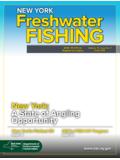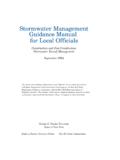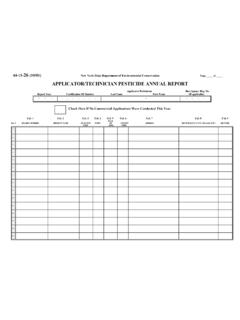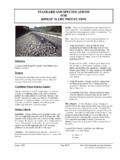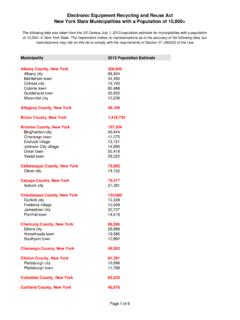Transcription of O S E 2 N BASIC FISHING TACKLE AND TECHNIQUES
1 2 START WITH THE BASICSE very angler has stories to tell: my first fish, my biggest fish, and, of course, the one-that-got-away. Before you can tell your own story, you need to hook your first fish. To make this happen, you need a rod, reel, hook, line, bait, lure and other TACKLE that will get you off to a good start. You also need to learn how to cast and how to choose the spots where you re most likely to catch fish in a lake, pond or stream. Once you learn these basics , it won t be long before you have your own stories to FISHING TACKLE AND TECHNIQUES15 Beginners Guide to Freshwater FishingS E C T I O N16 BASIC FISHING TACKLE AND TECHNIQUESB eginners Guide to Freshwater FishingWHAT DO I NEED TO GO FISHING ?The FISHING section of any sporting goods store can be overwhelming. There is so much FISHING TACKLE and fancy equipment to look at.
2 How do you decide what to buy? The truth is, all you need is a small investment in a beginner s rod and reel, a hook, line and some kind of bait or lure, and you ll soon be on your way to catching fish! ROD AND REEL TYPESYou can choose from four main types of FISHING rods and reels: spin-casting, spinning, bait-casting and fly rods. Spin-casting is generally considered the easiest to use while bait-casting and fly rods are considered the hardest to use. Spinning is considered the most versatile since it can cast light and moderately heavy lures/baits. For beginning anglers, a spin-casting rod and reel is ROD AND REELMost people start FISHING with a spin-casting rod and reel combo because it is easy to use. You cast using a push-button (right). Spin-casting TACKLE consists of a closed-faced reel mounted on top of the rod. Spin-casting reels can be used on any rod designed for bait-casting, but usually perform best on light- to medium-action rods.
3 If you are a beginner, use a rod that is your height or shorter for better control. FISHING LineFishing line is what connects you to the fish. While there are many different types of FISHING line to choose from, monofilament line (mono) is the best choice for beginning anglers. Mono is inexpensive and works well in most FISHING comes in different strengths called pound test. Choose a line that best fits the type of FISHING you plan to do. For example, when FISHING for bluegills and yellow perch, 4- to 8-pound test line is good. When FISHING for bass, use 8- to 12-pound test line. Eight-pound test is a good all-around line Your FISHING LineKeeping fresh line on your reel is very important. Old monofilament line becomes brittle and loses its strength. This can lead to broken line and a lost fish. If your line breaks easily after tying a knot, it s time to replace it.
4 You ll land more fish if you replace your line at least once a to begin? The variety of reels, rods, hooks and lures can be for instructions on how to tie line to your reel in the package of line you buttonhandlespin-castingspinningA closed-faced, spin-casting rod and reel is a good first FISHING TACKLE AND TECHNIQUESB eginners Guide to Freshwater FishingSetting the Drag All reels have a drag system that differs in appearance between reel types. The drag puts pressure on the reel s spool, setting how much force it takes to pull line off the reel. The tighter the drag, the harder it is to pull line off the reel. To tighten the drag, you turn one way (usually labeled with a + sign), and to loosen the drag, you turn the other way (usually labeled with a - sign). Setting the drag properly is important. You want the drag tight enough to set the hook and control the fish, but not so tight that the line breaks.
5 This gives you the ability to land a bigger fish than your line may be rated for. You can test the drag by pulling line off the spool with the reel engaged to retrieve line, as it would be if you hooked a fish. If the line you re using breaks, loosen the drag. If the line comes off too easily, tighten the drag. We recommend that you set the drag about 25% less than the pound test line you are using. This is done by feel, which gets better with how to cast well can greatly improve your chances of catching fish. Sometimes being able to cast far really helps, such as when you are trying to reach deeper water or when surf casting (casting into the waves). But casting accurately is usually more important. Fish love cover, such as a downed tree or a rock in the middle of a stream, so casting in just the right place without getting snagged will help you catch more fish.
6 Learn more about cover, and how to change your FISHING strategy to take advantage of it, later in this chapter. How to Cast1. When your line is ready and a practice plug is tied on (right), place the practice plug 6-12 from your rod tip. Before you cast, look behind you and make sure nobody is close enough to get hit by your cast. Check for trees and bushes that can get in your way. Make sure your line is not wrapped around your rod Press and hold down the reel s push button. 3. Using your wrist and elbow (not your whole arm), gently bring the rod straight up over your shoulder to about the ten o clock position. Gently sweep the rod forward, causing the rod to bend with the motion. When the rod is in front of you at about one o clock, release your thumb from the button. The bend in the rod casts the practice plug Turn the reel handle clockwise, and reel the practice plug back good way to practice casting is in your backyard (with a practice plug)When starting to cast, press and hold down the push button (see #2).
7 Practice plug18 BASIC FISHING TACKLE AND TECHNIQUESB eginners Guide to Freshwater FishingCast TroubleshootingSometimes when you are casting, things just don t work right. Use these simple tips to fix some common problems. I try to reel in, but the line doesn t come , when there is loose line on the reel, the reel can t pick up the line. Try pulling the line tight and then reel in. Most of the time, this fixes the problem. The handle fell off my reel!If you reel the wrong way, you can spin the handle right off the reel. Put the handle back on the reel and reel in the opposite direction. That will spin it back on correctly. Keep reeling in that direction to pick up the line. I cast, but the line doesn t go are two possible solutions:1. Check the rod tip to make sure the line isn t twisted around it. If it is, unwind the line and try to cast If the line is not tangled at the rod tip, it might be tangled in the reel.
8 Push down the button on the reel and let go, but do not start reeling in. Try to pull some line from the reel. If no line comes out, take the cap off the reel and try to untangle the and FISHING SafetyBelow are some safety tips to keep in mind while FISHING : Always walk when holding your FISHING rod. Don t run! When walking with the FISHING rod, always keep the rod tip up and behind you so it comes through the brush and trees easier. Make sure to attach the hook to a rod line-guide when not FISHING . This keeps the hook from swinging into branches or even people. Look around before you cast to make sure it s safe. You don t want to hit another person or get your line tangled in a tree. Stand on safe stable ground while FISHING from TACKLET erminal TACKLE is FISHING gear that is attached to the end of your hooks are one of the most important inventions of all time.
9 They have helped people catch fish for over 9,000 years. Today, there are many different styles of hooks to choose from, depending on how you are FISHING . For now we will stick to the of a Fish HookChoosing the right size hook is very important when targeting a certain species of fish. Hook sizes are classified by numbers ranging from the tiny #22, used for tying small flies, to the giant #16/0 used for shark FISHING . In between, are a variety of different sized hooks used for different sized fish. The chart that follows will help you decide which hook size to use. In general, use a hook that is not so big that a fish can easily detect it, but not so small that it can be easily BARBLESSSome people may prefer to use barbless hooks. Any hook can be made barbless simply by using a pair of pliers to bend the barb down. Barbless hooks are good to use when catch-and-release FISHING .
10 However, remember to keep a tight line when reeling in your fish, as you will not have the barb to help keep the fish on the casting, avoid bobber-snagging FISHING TACKLE AND TECHNIQUESB eginners Guide to Freshwater FishingBAIT HOOK SIZESHook SizeHook Length in InchesTroutNorthern PikeMuskellungeChannel CatfishBullheadSmallmouth BassLargemouth BassBluegillCrappieYellow PerchWalleyeSuckersCarpHook sizes are determined by length of shank excluding eyeSizes recommended for bait fishingBasic Fish HooksBait holder This style of hook has two barbs on the shank to help prevent bait from sliding down to the bend. This is a popular style of hook when using worms for This is the classic j-shaped hook. It is very popular when FISHING for panfish (such as sunfish and perch) and trout. It has a long shank that makes it easy to remove the hook from the fish.
